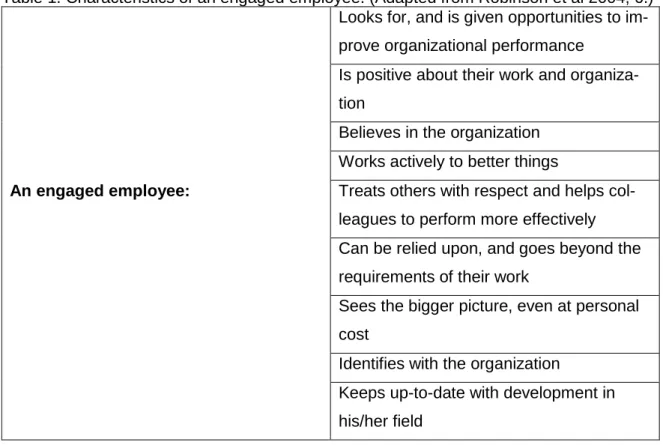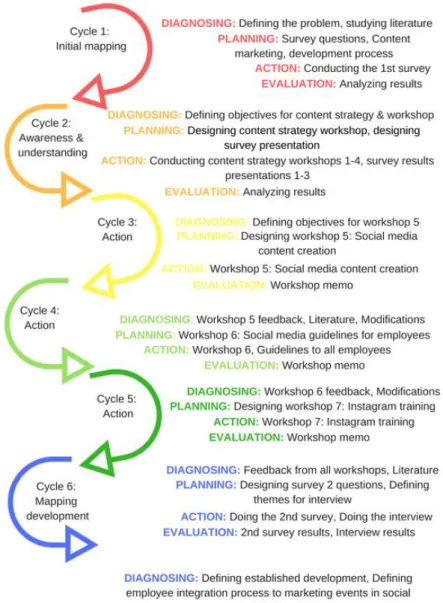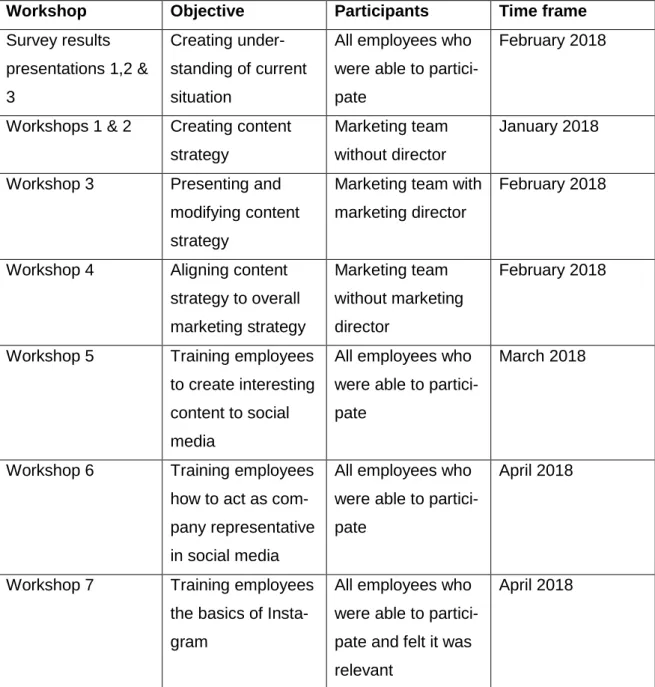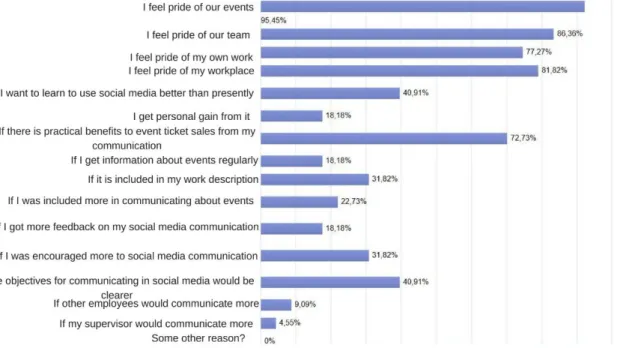In the age of social media, people have started to trust their friends and family as sources of information more than companies, celebrities or social influencers. This thesis is a development project that focuses on engaging employees in the promotion of live entertainment events in social media.
Case company
Objectives of the research & research questions
Structure of the thesis
Employee advocacy can also be defined as employees being brand ambassadors for the company they work for (Smarp 2017). The focus of this thesis is to develop the use of employee advocacy as a way of word-of-mouth marketing of Live Nation Finland events on social media.

Benefits for the company
Employee advocacy is also cost-effective as it generates organic reach that does not require financial investment. However, the focus in this thesis is on event marketing communication and employee engagement, but employee advocacy.
Benefits for the employee
Through employee advocacy, they can develop skills that are in high demand in their field and thus set them apart from their peers. Again, it is the millennials who most believe that employee advocacy benefits them to develop their skills, differentiate themselves from peers and gain access to more job opportunities.
Challenges
One of the challenges of employee advocacy is that it does not necessarily have clear guidelines or commonly understood definitions. This usually happens if the guidelines are not defined correctly (Smarp 2017), or if an employee advocacy project is simply launched without proper training and ordering all employees to participate in it.
Key success factors
The key drivers of employee engagement are discussed in a separate chapter, as well as the benefits and challenges of the concept. The key components of employee engagement research are both the organization and the employee.

Drivers of employee engagement
However, organizational citizenship behavior research is more interested in the character and behavior of the individual employee. The purpose of this research is to integrate the Live Nation Finland employees into the social media marketing communication of the company and through this involvement increase employee engagement.
Benefits and challenges of employee engagement
Integrated marketing communication is the practice of unifying all brand communication messages together with the messages of the marketing mix decisions (Moriarty et al 2015, 71). Because the company's focus in its IMC is in the events it produces or the artists it represents, the focus of this thesis is also in the marketing communication of events - not so much in the brand or image of Live Nation Finland.
Social media and content marketing
Integrating employees into Live Nation Finland's event marketing communications on social media aims to increase employee engagement and event awareness. For example, the key concepts of social media and content marketing theory helped create a specific content marketing strategy for the company.

Participatory action research approach
In this chapter, the research approach and the selected methodology - participatory action research - are explained. In addition, the data collection through employee surveys, workshops, internal data and interviews is described, as well as the methods used for data analysis. The aim was to facilitate the development of how Live Nation Finland's employees are integrated into the marketing communications of social media events.
My role as a researcher was to analyze the current situation, plan and implement developmental actions that drive employees to become advocates of the company's events, and evaluate the results. The participation method supports employee involvement and action research supports my own learning in leading change and improving the company's internal and external communication.
Methodological approaches
Collecting and analysing the data
- Surveys
- Workshops
- Internal data and observation
- Interview
- Analysing the data
At the end of the action research process, I conducted a follow-up online survey to determine possible development. The first survey in December 2017 was conducted as an initial mapping of the current level of employee advocacy and how much the employees of Live Nation Finland communicated events in social media. Therefore, the company employees were involved from the beginning of the action research project to increase the level of their involvement and improve results.
The objective for workshops 1, 2, 3 and 4 was to design a content marketing strategy for the company and plan the next steps of the action research process and the content of the employee workshops. These data emerged in discussions with my colleagues in different phases of the action research cycles. The survey results were used to understand the current situation of employee advocacy in the company - the first survey mapped the "before" situation and the follow-up survey the.

Action research process
- Cycle 1: Initial mapping
- Cycle 2: Creating awareness and understanding
- Cycles 3, 4 & 5: Action
- Cycle 6: Mapping development
I facilitated the first content marketing strategy workshop for the marketing team without the company's marketing director at the end of January and started with a brief analysis of the research results. The principles of brainstorming, where all group members silently write down ideas and later present them to the whole group, were introduced – again the aim was to increase the involvement of the marketing team. In addition, some members of the marketing team attended more than one presentation of the survey results.
I took notes of the workshop and evaluated its results in additional discussions with the marketing team. This increased understanding and awareness of using social media for the benefit of the company and employees. The involvement of Live Nation Finland employees in the company's event marketing communication continues in the company.

Reliability and validity of the study
Therefore, an interview with the company's marketing director was considered important to confirm the research findings and provide additional point of view on the action research process. In the final phase of the action research process in August, the survey and interview results were analyzed and evaluated. During cycle 6, the entire action research process was diagnosed and the validity and reliability of the research was analysed.
Involving the employees to use employee advocacy approaches and analyzing the effect on engagement and participation is part of the internal employee strategy. The chapter focuses on the research question about which factors involve the employees in communicating about the company's events. Finally, the chapter summarizes the findings in relation to the research questions in a separate chapter.
First survey findings: Level of employee advocacy and engagement
Only about 4 percent of respondents stated that they did not have any social media accounts. This is quite a high number and portrays both social media activity and engagement in communicating about company events. Up to 52 percent of respondents stated that they communicate either rarely or not at all about Live Nation Finland events on social media.
Therefore, the use of social media to communicate about the company's events is not completely out of the question for these respondents. Some respondents also requested training on what and when they can communicate about the company's events in social media. The employees have not been encouraged much before this to communicate about the events in social media.

Engaging employees towards advocacy
Follow-up survey results
The objective was to find out if employees were communicating more on social media about company events and if engagement tactics during the action research process were working. This initial indication of decreased communication was reversed later in the survey when employees rated whether their communication about company events had changed over the past six months. Likewise, in the July/August 2018 survey, nearly all respondents (92 percent) felt they could envision themselves communicating more about company events on social media, indicating that there was still enthusiasm among employees for advocacy employees.
In conclusion, the survey conducted in July/August 2018 showed that some progress has been made in involving employees in communicating about company events in social media. According to her, employee communication on social networks has changed over the past six months. Additionally, employees should have easy access to content and materials to develop their advocacy around company events.

Summarizing the findings
While the results of the first survey indicated that employees were engaged from the start and interested in communicating about the company's events on social media, they had mixed experiences. The first survey showed that almost all employees used social media and were interested in using it for company events. Based on the theoretical framework on employee engagement and advocacy, some key factors were selected and tested to help Live Nation Finland employees communicate about the events on social media.
Based on the data from the empirical research at Live Nation Finland and the literature on engagement and advocacy, I proposed a framework that could be used in the company to integrate the employees into event marketing communications. 42 percent of employees at Live Nation Finland felt they had started communicating more about the company's events on social media, which was a very positive result. It could also be seen that the mindset of the employees towards communicating about events on social media changed during the process.
Reflection on learning
The proposed framework for creating collaboration at Live Nation Finland could be used as a simple guideline in future projects. Since employee evaluation and involvement seemed to work in this development project, the methods could be useful in other projects as well.
Limitations of the study and recommendations for further research
It would also be interesting for Finland to investigate whether employee advocacy could have an impact on event ticket sales, company reputation or reducing event marketing costs. These metrics can be easily studied with the initialization of employee advocacy platforms that many companies provide, but they require an additional investment from the company. It is also worth considering whether a company with a relatively small workforce, such as Live Nation Finland, even needs a separate employee advocacy platform, which is typically used in companies with hundreds or thousands of employees.
Employee Advocacy on Social Media: How to Make It Work for Your Business: URL: https://blog.hootsuite.com/a-6-step-guide-for-creating-an-em-ployee-advocacy-program -for -your business/. URL: https://www.slideshare.net/linkedin-sales-solutions/social-buying-meeting-social-selling-how-trusted-networks-improve-the-purchase-experience-41076518. URL: https://ezproxy.haaga-helia.fi:3369/content/article/bestprac/what_we_know_about_internal_marketing_and_employee_engagement/112070.


